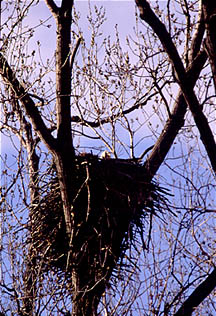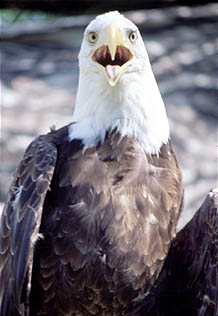![]()

Department of Environment and Conservation
Eagles at Ease With State Park Crowds
By David Haggard

Tennessee is home to a growing number of resident American Bald Eagles. This past winter at Reelfoot Lake State Park in Tiptonville, all facets of eagle behavior were visible to anyone who cared to invest a small amount of time.
Eagle’s nests are usually in remote places with limited access. Large areas around the nest are closed to all entry to prevent disturbance that could cause the adults to abandon the nest. Few people ever see an active Bald Eagle's nest, let alone have the chance to observe the fascinating courtship and nesting behavior, raising and caring for the young and, finally, the first flight of the young birds.
In early December 1997, park staff and numerous visitors observed a pair of adult Bald Eagles engaging in courtship displays. They chased each other through the sky, touching wings and locking talons, sometimes free-falling hundreds of feet locked in an aerial embrace. They began to carry limbs from tree to tree, try to chose the perfect home.
Local residents and park staff followed the birds, trying to find the nest. Early one morning, Ranger Michael Walton looked out his window and saw the eagles busily building their nest in a large cypress tree overlooking the boardwalk directly behind the Visitor’s Center. Everyone was amazed because eagles typically nest in remote places, not overlooking houses and busy restaurants and Visitor’s Centers. Maybe they liked the company of the three injured eagles in the aviary nearby.
The pair steadily carried broken branches and large limbs and the nest quickly took shape. The male eagle, slightly smaller than his mate, would fly into a tree with his talons outstretched, grab a branch and wrench it free. He would carry the offering back to the nest where the female would arrange it to her satisfaction. By the end of December, the nest was mostly complete. Only minor rearranging of the nest followed. The nest is elevated 70 feet above the water and is six feet high and five feet wide, weighing several hundred pounds. It is an awesome structure, not by any means a typical bird's nest.
There are two main philosophies on how to manage an eagle nest. One is to close the area around the nest for approximately one mile. The other is to keep the nest location a secret so that it will receive a minimum amount of disturbance. Neither option was feasible for this location. After discussions with Tennessee Wildlife Resource Agency and United States Fish and Wildlife Service personnel, it was decided to close only the essential area underneath the nest.
This pair of eagles exhibited an amazing tolerance for people. People were observed walking under the nest as the female eagle watched over the side, showing no fear. Large groups of noisy visitors, including children, caused an increased level of alertness, but no alarm.
As visitation increased in January of 1998, park personnel decided to close the section of boardwalk directly under the nest. Observation areas were set up where naturalists, armed with telescopes, could help visitors observe the nest and birds and provide interesting eagle facts. This area is less than 100 yards from the nest, so everyone could get an eagle's eye view of the eagles watching people watching them.
The Bald Eagle is one of the earliest nesting birds in Tennessee, with one, two, or three large white eggs laid in mid to late February. Eagles may have to incubate the eggs with snow on their backs in sub-zero temperatures. Starting in early February, the female stayed near the nest and the male carried large amounts of grass and leaves for her to line the nest.
On February 14, 1998, the female remained in the nest and it appeared that egg laying had begun. During the next week, the female eagle was not observed leaving the nest. The male brought in fish several times a day. He would sit above the nest when not searching for food.
Hundreds of visitors observed the nest and birds everyday and got a first hand look at eagle behavior. Several times each day, the female would stand and stretch then take her large powerful beak and gently turn the eggs. The female handled most of the incubation duties, but the male occasionally helped. At night, the female had the duty of sitting with the male on a nearby limb. He left at sunrise to look for breakfast and usually returned quickly with an entree. After breakfast, the female took off and the male took his turn on the nest. Usually, the female returned in mid-morning and the male took off and did not look back. Being the typical male, when he saw her return, he was gone. This was always amusing to watch; no visiting, no calling, just a fast exit.
Normal incubation for eagle eggs is 35-40 days. As hatching time approached, hundreds of people called or stopped by to check the status of the eggs. In late March, the first signs of new life appeared. The female, joined by the male, sat on the side and stared into the nest. When dad brought in fish, mom shredded small pieces and gently fed the chick. In about two weeks, a small gray head appeared, looking in wonder at his surroundings. As the news spread, visitors came from everywhere to observe the parents and young bird.
Young eagles grow fast and require large amounts of food. Both parents spent most of the day searching the lake. A variety of groceries were delivered to the nest. The favorite food was fish and drum was the species delivered most often. Other fish identified included shad, carp, catfish, gar, and crappie. Other food items taken to the nest included coots, ducks, an unlucky rabbit, and numerous turtles. The turtles were small, about hand size, and were a major food source.
Junior started exercising his wing muscles at about six weeks, standing on the edge of the nest and flapping those huge wings. By nine weeks, he was jumping out of the nest onto nearby limbs to test his flying skills and he was almost ready for his maiden flight.
On June 16, away he flew! He jumped from the nest and soared away, graceful and powerful. Then, he sailed over the lake, dipping and turning with his proud parents nearby. When it was time to land, he moved toward a cypress tree, but was too fast. He hit the limb with both feet and flipped forward, hanging upside down. Junior looked at an upside down world with a quizzical expression. Unable to hold on any longer, he let go and fell. He regained his equilibrium and sailed into the nest for an easy landing. Home again, better luck next time. Practice makes perfect.
Training continued for the next several weeks, as the youngster learned to fly, fish and land with his catch. The family stayed together and the adults watched over junior. Summer was a time of learning with plentiful food and few dangers. Winter will bring the true test of survival. In a dangerous world, four of 10 young eagles will not live to be one year old.
An extremely large brown bird, junior stood three feet tall with a six foot wing span. He weighed about 12 pounds. His coloration will slowly change over the next five years until sexual maturity is reached. With a black body and a creamy white head and tail, the adult eagle cannot be mistaken for anything other than our national symbol.
Eagles usually return to the same nest year after year, adding material until the structure is unbelievably large. The largest ever found was a massive structure of over 20 feet high, 10 feet wide and weighing over 4,000 pounds.
The eagles were expected to return to the Visitor’s Center nest in the late fall of 1998. This nest provides a unique viewing opportunity and learning experience for those who love nature.
Thousands of visitors make the trip to Reelfoot Lake every winter to view the migratory eagles and now they can also observe an active nest. This is truly one of the best locations in the south to view our national symbol flying wild and free.
For more information about the Bald Eagles of Reelfoot Lake please contact: Reelfoot Lake State Park
Eagle Tours, Route 1, Box 2345, Tiptonville, Tenn. 38079.
Call 1-800-250-8617 (Toll Free.)
(David Haggard is an interpretive specialist at Reelfoot Lake State Park. In winter, he guides eagle tours.)
 Tennessee’s
Eagles Make A Comeback
Tennessee’s
Eagles Make A Comeback
The Bald Eagle has rebounded from the brink of extinction. Tennessee now boasts approximately 38 occupied Bald Eagle nests. These nests produced roughly 40 young eaglets in 1998. Although nests are scattered across the state, the majority are near Reelfoot Lake and Land Between the Lakes, the sites where young eagles were released throughout the 1980s.
Between 1980 and 1997, 269 young bald eagles were released across Tennessee. Many of these birds have chosen to stay. In 1983, Reelfoot personnel saw the first successful Bald Eagle nest in 22 years and more nests quickly followed.
As more birds become acclimated to our activities, their future is assured. In 1954, 14 active Bald Eagle nests were found at Reelfoot Lake; by 1961 they were gone. Eagles did not successfully nest in Tennessee until 1983. Winter migrants still came, but eagles did not consider the Volunteer State their home.
STX/TCM/sidebar with Reelfoot eagle story/Oct. 4, 1998
Updated January 1, 1999; Send comments to Department of Environment and Conservation.